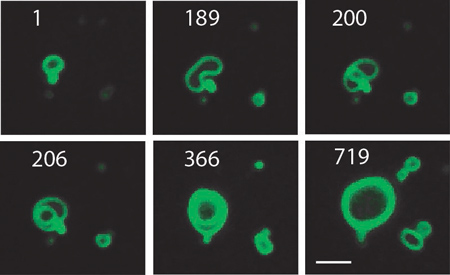Scientists Create Synthetic Membranes That Grow Like Living Cells
June 22, 2015
By Kim McDonald

Growing cell membranes are seen in this time lapse sequence (numbers correspond to minutes of duration).
Michael Hardy, UC San Diego
Chemists and biologists at UC San Diego have succeeded in designing and synthesizing an artificial cell membrane capable of sustaining continual growth, just like a living cell.
Their achievement, detailed in a paper published in this week’s issue of the Proceedings of the National Academy of Sciences, will allow scientists to more accurately replicate the behavior of living cell membranes, which until now have been modeled only by synthetic cell membranes without the ability to add new phospholipids.
“The membranes we created, though completely synthetic, mimic several features of more complex living organisms, such as the ability to adapt their composition in response to environmental cues,” said Neal Devaraj, an assistant professor of chemistry and biochemistry at UC San Diego who headed the research team, which included scientists from the campus’ BioCircuits Institute.
“Many other scientists have exploited the ability of lipids to self-assemble into bilayer vesicles with properties reminiscent of cellular membranes, but until now no one has been able to mimic nature’s ability to support persistent phospholipid membrane formation,” he explained. “We developed an artificial cell membrane that continually synthesizes all of the components needed to form additional catalytic membranes.”
A time-lapse video shows increase in vesicle volume and membrane surface area at 60 second intervals over a period of 12 hours.
Michael Hardy, UC San Diego
The scientists said in their paper that to develop the growing membrane they substituted a “complex network of biochemical pathways used in nature with a single autocatalyst that simultaneously drives membrane growth.” In this way, they added, “our system continually transforms simpler, higher-energy building blocks into new artificial membranes.”
“Our results demonstrate that complex lipid membranes capable of indefinite self-synthesis can emerge when supplied with simpler chemical building blocks,” said Devaraj. “Synthetic cell membranes that can grow like real membranes will be an important new tool for synthetic biology and origin of life studies.”
Other members of the UC San Diego team were Michael Hardy, Jun Yang and Christian Cole of the Department of Chemistry and Biochemistry and Jangir Selimkhanov and Lev Tsimring of the BioCircuits Institute.
Support for the research project was provided by UC San Diego, US Army Research Laboratory, US Army Research Office and the National Science Foundation.
Media Contact: Kim McDonald, 858-534-7572, kmcdonald@ucsd.edu
Comment: Neal Devaraj, (858) 534-9539, ndevaraj@ucsd.edu
